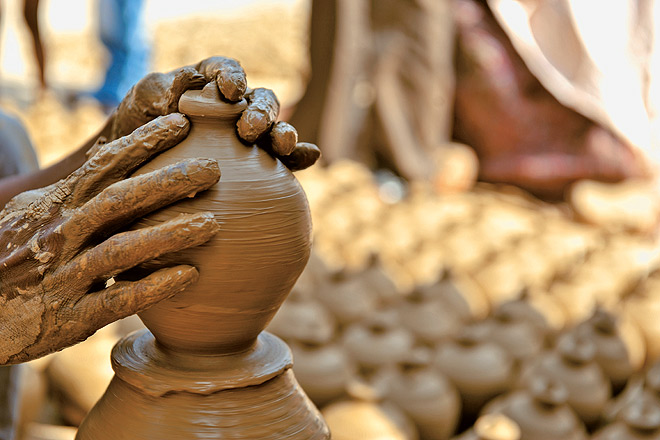My new friend Nandu inserted two naked wires into a socket and the wheel whirred to life.
I had spent the last four-odd hours walking through the streets of Kumhaargram, a Rajasthani potters’ settlement in West Delhi, with Piyush Nangru from Indomania Cultural Tours. The colony of potters had shifted to Delhi from Rajasthan decades ago, and then shifted base in Delhi three times before finding its current location – apparently, objections were raised over the smoke generated by the kilns.
We started the tour with a visit to Nandu’s house – big, with a central courtyard, the main attraction of which was a kiln that was resting after baking a large consignment of custom-made pots for one of Nandu’s foreign customers. His storage area was empty save for a few damaged hand-painted pieces. Nandu explained that all his pottery was created on the wheel. Other methods of creating pottery were shown to us later, as we walked through the village.
We headed out of Nandu’s house onto the village’s main street. Cows, dogs and curious stares followed us wherever we went. Patches of the road were piled with loads of dry clay, which women and children were beating into a fine dust with wooden paddles. “This is how women contribute to the process,” Piyush explained. Once enough finely powdered clay is collected for the next day’s work, it’s soaked in water through most of the day and then overnight. The result: velvety smooth and cream-like clay.
We turned onto a mud road lined with exposed brick houses, most of which housed kilns in their front rooms. Down the road, the houses gave way to thatched huts filled with pots of every size and shape. Here we witnessed another way of creating pottery – the mould method. In this, clay balls are rolled out as huge roti-like sheaths and then pressed into semi-circular moulds with a damp cloth. The top and bottom moulds are fixed together with a strip of rolled out clay and left to dry in the sun until they are deemed ready for the kiln. Further down the road, we saw double-baked pottery, and round matkas (beaten into shape once they are partially dry).
Covered head-to-toe in dust and sweat, we turned a corner to see a curious sight: a house built entirely of matkas stacked one on top of the other in parallel rows, the gaps between them filled with clay. Piyush explained that the pots kept the house insulated in winter, and surprisingly cool even on the hottest summer day! We walked past rows of newly-built houses, the interiors of which were covered entirely with tiles – a sign of prosperity in the area. The walk also took us past small and large displays of pottery composed of scores of diyas, foot scrapers, vases, figures – you name it and they’ve got it. We then stopped by a women’s centre for a brief conversation with a nurse who educates the area’s women on the benefits of birth control, and out of there into the blazing heat yet again to soak in more the sights. As it turned out, the best was yet to come: I was to try my hand at pottery.
Later, as we revelled in air-conditioned bliss, sipping cups of tea and devouring pakoras, Piyush told us that he worked closely with the South Asia Foundation, which promoted the work of these potters around the world. No wonder everyone we had met treated Piyush like a demigod. As we walked back towards the car, I looked at the little clay vase I had created. After all, what was a day of activity worth if you had nothing tangible to show at the end of it?
The Pottery Village Tour is one of five walks offered by Indomania Cultural Tours (Rs 2,000 per person; +91-8860223456; indomaniatours.com). Bookings as per convenience.
heritage walk
Kumhaargram potters
Rajasthani potters
Leave a Reply
You must be logged in to post a comment.





